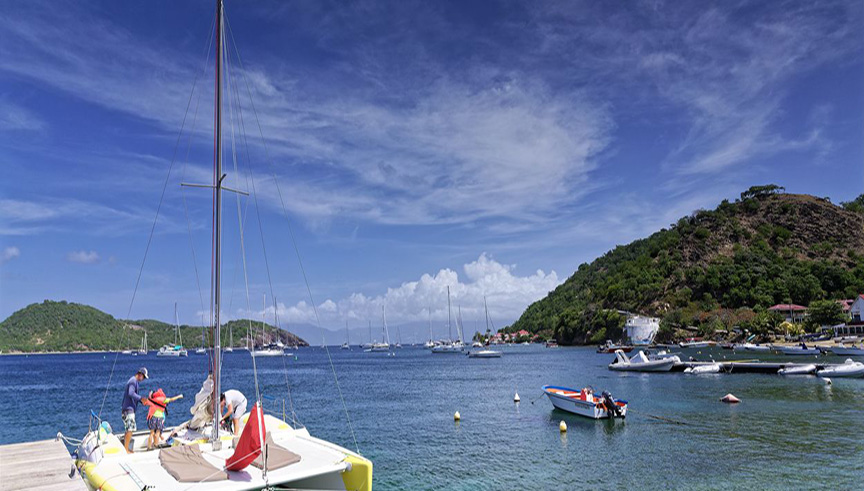
- by Simone
I’ve visited many beautiful places, but Guadeloupe, nestled in the Caribbean, holds a special place in my heart. The island’s unique charm and stunning natural beauty make it an irresistible destination. If you’re planning a trip to this paradise, here are some practical tips that will help you make the most of your adventure.
1. How to Get to Guadeloupe?
Guadeloupe, an overseas region of France, is relatively easy to reach from Europe, especially from France itself. The island’s connection to France means that traveling from major European cities, particularly Paris, is straightforward and convenient. Multiple airlines offer frequent direct flights from Paris to Guadeloupe, with the journey typically taking around 8 hours. These flights are available from both Charles de Gaulle Airport (CDG) and Orly Airport (ORY), providing travelers with flexible scheduling options.
For those traveling from North America, particularly from Canada, the journey to Guadeloupe is equally accessible. Direct flights from Montreal or Toronto to Guadeloupe are available year-round, making it a convenient destination for Canadians seeking a tropical getaway. The flight duration from these Canadian cities is approximately 5 to 6 hours, making Guadeloupe an attractive option for a winter escape or a summer vacation.
Upon arrival, you’ll land at Pointe-à-Pitre International Airport, which serves as the main gateway to the island. This modern airport is well-equipped with facilities such as car rental services, cafes, and shops, ensuring a smooth transition from your flight to your island adventure.
Renting a car in Guadeloupe is highly recommended as it provides you with the freedom to explore the island at your own pace. Car rental services are conveniently located at the airport, offering a range of vehicles to suit different needs and budgets. Whether you’re planning to navigate the bustling streets of Pointe-à-Pitre, venture into the scenic countryside, or explore the island’s pristine beaches, having your own vehicle will allow you to discover Guadeloupe’s diverse landscapes and hidden gems without the constraints of public transportation schedules.
If renting a car isn’t your preference, taxis are readily available at the airport. However, keep in mind that taxis can be more expensive, especially for longer journeys across the island. For those staying in resort areas, some hotels also offer shuttle services, which can be a convenient alternative for getting to and from the airport.
Whether you’re coming from Europe or North America, getting to Guadeloupe is straightforward, and once you arrive, renting a car is the best way to ensure you can fully explore all that this beautiful island has to offer.
2. When Is the Best Time to Visit Guadeloupe and How Long Should You Stay?
Guadeloupe’s tropical climate is one of its most appealing features, offering warm temperatures and pleasant weather throughout the year. The island enjoys consistent warmth, with temperatures generally ranging from 24°C to 30°C (75°F to 86°F). However, if you want to make the most of your visit and enjoy the best weather conditions, the dry season from December to April is the optimal time to go.
Best Time to Visit: December to April
During the dry season, you can expect long, sunny days with minimal rainfall. This period is characterized by lower humidity and clear skies, creating ideal conditions for beach activities and outdoor exploration. The dry season offers some of the best weather for snorkeling, swimming, and sunbathing. The waters around Guadeloupe are crystal clear, making it perfect for those who want to dive into the vibrant marine life or simply relax on the pristine sandy beaches.
From December to April, the island experiences a pleasant trade wind that helps to keep temperatures comfortable, even in the warmest months. This gentle breeze provides a cooling effect, making outdoor activities more enjoyable and reducing the overall feeling of heat. Additionally, this period is less prone to tropical storms and hurricanes, which are more common during the rainy season from June to November.
Duration of Stay: 7 to 10 Days
For a well-rounded experience of Guadeloupe, I recommend planning for at least 7 to 10 days. This duration allows you to fully immerse yourself in the island’s diverse offerings and ensures you don’t miss out on any key attractions.
- Days 1-3: Grande-Terre
Start your journey in Grande-Terre, where you can explore the lively city of Pointe-à-Pitre and relax on its beautiful beaches like Sainte-Anne and Saint-François. Spend a couple of days soaking up the sun, exploring local markets, and indulging in the island’s culinary delights. Take the time to visit key landmarks and enjoy the vibrant atmosphere of the capital city. - Days 4-6: Basse-Terre
Transition to Basse-Terre to experience its natural wonders. Dedicate a few days to hiking the La Soufrière volcano, exploring the lush rainforest, and visiting the Jardin Botanique de Deshaies. You’ll find ample opportunities for adventure and relaxation, from waterfalls and hiking trails to botanical gardens and scenic viewpoints. - Days 7-8: Les Saintes
Take a ferry to Les Saintes for a change of pace. Spend a day or two exploring the picturesque villages, enjoying the stunning beaches, and visiting Fort Napoléon. The slower pace of life on these small islands will provide a perfect contrast to the busier areas of Grande-Terre and Basse-Terre. - Days 9-10: Leisure and Exploration
Use the last days of your trip to revisit your favorite spots, enjoy additional activities, or simply relax before heading home. Whether it’s a final beach day, a leisurely stroll through local markets, or a last-minute adventure, these extra days will help you make the most of your stay.
Additional Tips
- Advance Booking: During the peak dry season, accommodations can book up quickly. It’s a good idea to book your flights and lodgings well in advance to secure the best options and rates.
- Sun Protection: The Caribbean sun can be quite intense. Make sure to pack sunscreen, a wide-brimmed hat, and sunglasses to protect yourself while enjoying the outdoor activities.
- Local Events: Check for local festivals or events happening during your visit. Guadeloupe hosts various cultural celebrations throughout the year that can add a unique touch to your travel experience.
By planning your visit during the dry season and allowing sufficient time to explore both the main island and its surrounding smaller islands, you’ll be able to fully appreciate the natural beauty, cultural richness, and warm hospitality that Guadeloupe has to offer.
3. Accommodation Guide in Guadeloupe
Guadeloupe offers a wide range of accommodation options to suit different budgets and preferences. If you’re looking for luxury, the resorts in Sainte-Anne and Saint-François on Grande-Terre are excellent choices. These areas boast beautiful beaches, luxurious amenities, and top-notch service. However, if you prefer a quieter and more authentic experience, consider staying in a boutique hotel or guesthouse on Basse-Terre or Les Saintes. These accommodations not only provide a closer connection to nature but also offer a chance to immerse yourself in the local culture. Some of these smaller establishments are family-run, adding a personal touch to your stay.
4. How to Explore Guadeloupe?
The public transportation system in Guadeloupe is relatively limited, making it less convenient for travelers who want to explore the island thoroughly. Buses and shuttles primarily serve the main towns and a few tourist spots, but they are not frequent, and routes can be confusing for those unfamiliar with the area. This is why renting a car is by far the most practical and efficient way to get around. With a car, you have the freedom to explore every corner of Guadeloupe at your own pace, without being tied to the often unreliable and sparse public transport schedules.
Getting Around by Car: What You Need to Know
Driving in Guadeloupe is relatively straightforward, with well-maintained roads that connect the major towns, beaches, and attractions. The island follows standard European driving conventions, so if you’re familiar with driving in France or other European countries, you should find it easy to navigate. Road signs are in French, and most are clearly marked. The main roads are paved and generally in good condition, though some of the smaller, more remote roads may be narrow and winding, especially in the mountainous areas of Basse-Terre. A GPS or a good map is highly recommended, as it will help you find your way to less touristy spots and avoid getting lost on the island’s scenic but sometimes complex road network.
Suggested Itinerary: How to Divide Your Time

For first-time visitors to Guadeloupe, I suggest dividing your itinerary into several key regions, each offering unique experiences and landscapes.
1. Grande-Terre: Beaches, City Life, and Cultural Experiences
Start your journey in Grande-Terre, the eastern half of the butterfly-shaped island, known for its stunning white-sand beaches and lively urban atmosphere. Pointe-à-Pitre, the capital of Guadeloupe, is a bustling city with a rich cultural heritage and a vibrant marketplace. Here, you can spend a day exploring the local markets, such as Marché de la Darse and Marché Saint-Antoine, where you’ll find everything from fresh tropical fruits to handmade crafts and Creole spices. The colorful streets of Pointe-à-Pitre are also dotted with boutiques, cafes, and restaurants, making it a great place to immerse yourself in local life.
After soaking up the city vibes, head to the coast where Grande-Terre’s most famous beaches await. Sainte-Anne and Saint-François are particularly popular, offering powdery white sand, turquoise waters, and a range of water activities such as snorkeling, windsurfing, and paddleboarding. These areas are also home to some of the island’s best resorts and beach clubs, where you can relax with a cocktail in hand, basking in the Caribbean sun.
2. Basse-Terre: A Nature Lover’s Paradise
Next, drive over to Basse-Terre, the western part of the island, which is a stark contrast to the flat, beachy terrain of Grande-Terre. Basse-Terre is dominated by lush rainforests, dramatic mountains, and the majestic La Soufrière volcano. This region is a paradise for nature enthusiasts and outdoor adventurers.
One of the highlights of Basse-Terre is hiking to the summit of La Soufrière, an active volcano that offers one of the most rewarding experiences on the island. The hike is challenging, taking about 3-4 hours round trip, but the views from the top are nothing short of spectacular. On a clear day, you can see across the entire island and even to neighboring islands such as Dominica and Montserrat.
For a more leisurely experience, explore the island’s tropical rainforest. Parc National de la Guadeloupe is a must-visit, with well-marked trails that lead you through lush vegetation, past waterfalls, and to lookout points with breathtaking views. The park is also home to a variety of wildlife, including tropical birds, butterflies, and rare plants.
Another gem of Basse-Terre is the Jardin Botanique de Deshaies, a beautifully landscaped botanical garden that showcases the island’s rich flora. The garden is set on a hillside, offering stunning views of the Caribbean Sea, and features a wide variety of tropical plants, flowers, and trees. There’s also a charming little cafe within the garden where you can enjoy a refreshing drink while taking in the serene surroundings.
3. Les Saintes: A Serene Island Escape
Finally, take a short ferry ride to Les Saintes, a small archipelago just off the southern coast of Basse-Terre. Les Saintes is often described as one of the most picturesque places in the Caribbean, with its charming villages, crystal-clear waters, and laid-back vibe. Terre-de-Haut, the main island of Les Saintes, is a perfect destination for a day trip or a short stay.
One of the first things you’ll notice about Terre-de-Haut is its tranquil, almost timeless atmosphere. The island’s main village, also called Terre-de-Haut, is a delightful mix of colorful Creole houses, narrow streets, and quaint shops and cafes. Renting a scooter or an electric bike is a popular way to get around the island, allowing you to easily explore its many hidden beaches and scenic viewpoints.
A visit to Fort Napoléon is a must while you’re in Les Saintes. This historic fort, perched on a hill overlooking the bay, offers panoramic views of the island and the surrounding sea. The fort also houses a museum that delves into the island’s history, including its role in the Napoleonic Wars and its cultural heritage. The museum’s exhibits include artifacts, maps, and displays that provide fascinating insights into the island’s past.

After exploring the fort, spend the rest of your day enjoying the natural beauty of Les Saintes. Plage de Pompierre, a beautiful crescent-shaped beach sheltered by palm trees and cliffs, is an ideal spot for swimming and relaxing. The calm waters here are perfect for snorkeling, allowing you to explore the vibrant marine life just offshore.
Exploring Guadeloupe by car gives you the flexibility to experience the island’s diverse landscapes and attractions at your own pace. By dividing your time between Grande-Terre, Basse-Terre, and Les Saintes, you’ll be able to fully appreciate the unique character and beauty of each region. Whether you’re seeking adventure, relaxation, or cultural experiences, Guadeloupe has something to offer every traveler.
5. Where to Eat and Play?
Guadeloupe’s cuisine is a delightful blend of French and Creole influences, offering a diverse range of dishes. I highly recommend trying the local seafood and Creole dishes, such as grilled fish seasoned with local spices, seafood stews, and tropical fruit salads. In Pointe-à-Pitre, you’ll find numerous upscale restaurants that serve exquisite meals, while in smaller towns and along the beaches, there are plenty of cozy eateries and food stalls offering authentic local flavors.
For those who enjoy nightlife, Pointe-à-Pitre’s bars and clubs are the place to be. Here, you can immerse yourself in the lively rhythms of Caribbean music and dance the night away. If you prefer a more relaxed experience, nothing beats a sunset stroll along the beach or a boat trip to watch the sun dip below the horizon, painting the sky with stunning colors.
Guadeloupe is a destination that offers a perfect blend of natural beauty and cultural richness. Whether you’re looking to unwind and relax or seek out adventure, this island has something for everyone. I hope these tips help you plan your Guadeloupe trip, and may your journey be filled with unforgettable experiences!